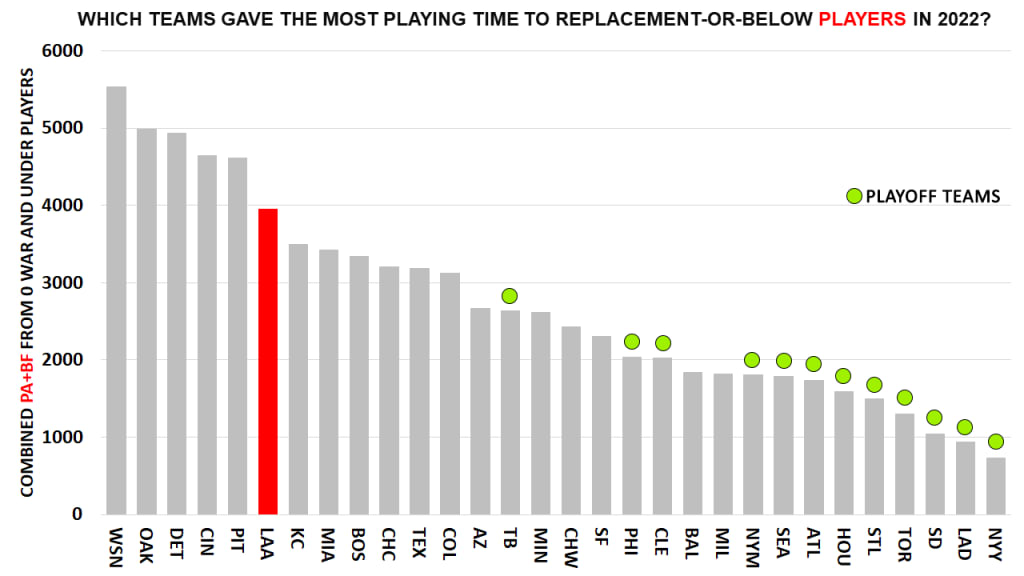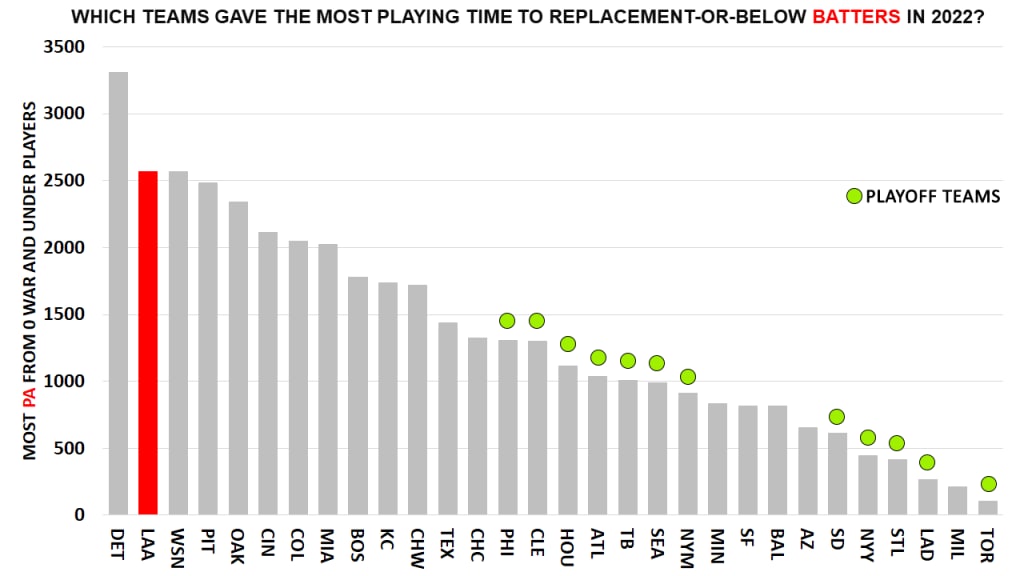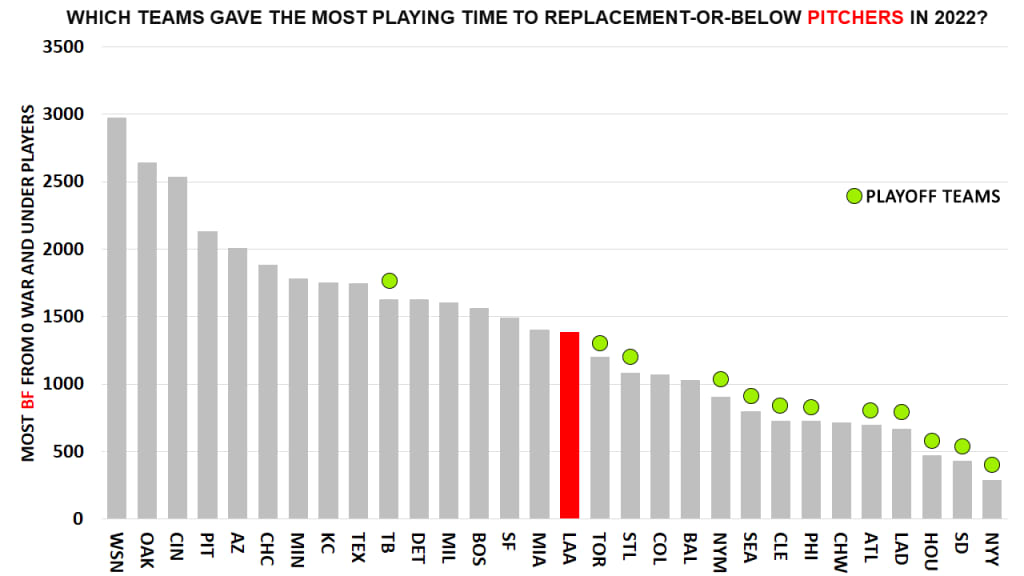For each of the last eight seasons, Mike Trout’s season has ended in the same way: At home, maybe watching the Eagles, or following the weather. Doing anything, really, except for appearing in the Major League Baseball postseason.
For the last five of those years, teammate Shohei Ohtani’s season has ended the same way. The Angels have two of the most talented players to ever pick up a baseball, and it hasn’t mattered. Forget the postseason, really; the team hasn't even finished above .500 since 2015.
Meanwhile, 2023 has long represented something of a tipping point, because Ohtani is entering his final year before free agency, and because Trout, while still outstanding, is 31 and has been beset by injuries, having not played more than 140 games since 2016.
It might not be exactly “now or never,” but it certainly feels like it, especially because the club has just two names in the recently released MLB Pipeline Top 100 Prospects list. In the midst of lingering uncertainty at the ownership level, GM Perry Minasian took a different path this winter. He didn’t get superstars. He got competent, useful Major League players. It’s not exciting. It’s not provocative. But it might just matter more than it seems.
After all, “having superstars” has never been the problem here. It’s the support around them -- or lack of it -- that has.
To illustrate that, the importance of depth, let’s go back to last year and run a simple test to find “competency.” In Wins Above Replacement terms, 2 WAR is considered "average" -- this is not a bad thing, necessarily, as solid starters like Rhys Hoskins and J.P. Crawford were in this range -- and 0 WAR is, well, “replacement,” or the assumed level where you could theoretically find someone equally good in the Minors. If someone is performing under this level, it’s a good sign they’re not helping you win.
Which teams, then, gave the most playing time (both batters and pitchers) to these completely non-productive 0-WAR-and-under players, by FanGraphs' reckoning? Look at the clubs around Los Angeles, and where the postseason teams rated here, and it tells you a lot about the problems of the Angels.

It’s not what you want.
Those first five teams should make a lot of sense: Washington, Oakland, Detroit, Cincinnati and Pittsburgh each lost at least 96 games. The two teams after the Angels make sense: Kansas City and Miami both lost more than 90 games. Those seven clubs weren’t without notable or even very good players, of course. But they didn’t have Trout. And they didn’t have Ohtani.
To take the extremes, the 107-loss Nationals gave 5,543 plate appearances to players under 0 WAR. The 99-win Yankees gave 736. “It’s better to have better players” is not exactly earth-shattering news, but remember that we haven’t even split average from great here. All this is showing is adequate vs. unacceptable.
“We need everybody, because depth is important and things happen over the course of a year,” Minasian said in November. “We feel like they're really good players. We have some high-end guys and now, we're trying to fill some of that middle part of our roster with quality.”
Exactly, though it’s not quite the same for pitchers and hitters. Let’s start with the position players to see what they’ve done.
POSITION PLAYERS
We’ll repeat the same chart from above, this time just for position players. When you look at this, remember that this is a team that gave 1,165 plate appearances to elite hitters in Trout and Ohtani, plus had 564 more plate appearances' worth of Taylor Ward’s breakout season. That’s three of the top 25 hitters in the sport, at least among those with 400 plate appearances, yet the Angels scored just the 25th-most runs of the 30 teams, and, well, this tells you why.

This, right here, is the entire problem. The Angels gave 2,571 plate appearances -- that’s 43% of their entire season -- to players who were, to be frank, just not very good. That’s second only to the Tigers, who just had one of the weakest position-player seasons in the long history of the franchise, and that’s nearly 24 times the mere 108 unacceptable plate appearances Toronto had, almost all of which were from fifth outfielder Bradley Zimmer.
To illustrate that a little further, the Angels had the 10th-most plate appearances taken by 3+ WAR players, because they did have some extremely good players. But if you have a ton of plate appearances from unacceptable players, and also a large number of plate appearances from very good players, what you’re missing is the middle class. No team had fewer plate appearances taken by players between 0 WAR and 3 WAR. It’s still true between 1 WAR and 3 WAR. It’s still true (tied, anyway) between 2 WAR and 3 WAR.
It’s hard to find a higher-variance lineup, and it’s hard to win that way. Clearly. For the most part, Luis Rengifo (103 OPS+) and pre-trade Brandon Marsh (who supplemented a poor 80 OPS+ with excellent defense) were the only middle-class players the Angels ran out in 2022. Everyone else was either great or inadequate.
It’s not entirely their fault, of course. A full 454 of those plate appearances went to Jared Walsh, who had been an All-Star in 2021, yet suffered through an unexpectedly miserable (81 OPS+, -0.6 WAR) and injury-plagued season in 2022. But it could look worse, too, given that 349 plate appearances went to Andrew Velazquez, who hit only .196/.236/.304 (53 OPS+) yet managed to finish ever so slightly above our 0 WAR line at 0.3 WAR, thanks to solid enough defense.
In: OF Hunter Renfroe, INF Gio Urshela, INF Brandon Drury, OF Brett Phillips, C Logan O’Hoppe
Setting aside O’Hoppe for a moment, the four veterans here combined to hit 12% above league average in 2022 and post 8 WAR, which you shouldn’t average four ways -- they certainly didn’t all have the same playing time -- but we choose to anyway because saying “four exactly average 2 WAR players added” fits the narrative pretty well. Renfroe, setting aside 2020, is the platonic ideal of “the average 2 WAR player.” It’s what he does. He also looks a whole lot like Trout. Phillips is a poor hitter, yet he's in the conversation for the best defensive outfielder in the game.
Out: C Kurt Suzuki, INF Matt Duffy, INF Tyler Wade, INF Jonathan Villar, INF Jack Mayfield, INF José Rojas, OF Juan Lagares, OF Jo Adell
This isn’t the full accounting of their offseason, but it’s the bulk of it, and this group named here combined for more than 1,100 plate appearances of play so weak it was worth minus-4 WAR just from this collection. (Adell alone does remain with the organization, but is likely to spend most of the year in the Minors unless disaster strikes.)
Trout, Ohtani, and Ward remain, of course. It’s fair to expect more from a healthier Walsh, and “solid” is a fair expectation of Rengifo. David Fletcher’s defense should be enough to keep him above replacement, despite a punchless bat; it’s anyone’s guess what to expect from Anthony Rendon, though “above replacement level if available” isn’t unreasonable. Let’s not overthink this too much, of course. You’d rather give Renfroe the plate appearances that Adell got, but you’d really rather have given, say, Brandon Nimmo those plate appearances. Urshela is better than Duffy, but he’s not Carlos Correa, either.
Stars are, obviously, better than solid players. But failing that, solid players over sub-replacement ones are pretty important, too.
PITCHING
It’s not quite as bad here. After all the years where the Angels' pitching was the problem, in 2022, it was just a problem.

(Wait, the Rays? We were surprised, too. Then again, they did give more than 200 innings to a group of pitchers including but not limited to Calvin Faucher, Josh Fleming, Dusten Knight, and Luis Patiño, who combined for an ERA of nearly 5.00.)
In this case, it’s not as much about who the Angels have cut loose -- severing ties with unproductive arms like Mike Mayers, Oliver Ortega, and Elvis Peguero is nice but won’t meaningfully change the bottom line -- as it is who they’ve added, both internally and externally.
That includes Tyler Anderson, coming off an All-Star season for the Dodgers, and Carlos Estévez, a durable flamethrower with obvious upside now that he’s finally escaped Coors Field. But it might also include Griffin Canning and Chris Rodriguez, on their way back from injury, and it might also include Chase Silseth, a 2021 Draft pick who didn’t impress in his brief taste of the Majors last year but had dominated in the Minors on the way up. As of Feb. 7, the Angels are projected for the 13th-best pitching and 12th-best position player group.
That still might not be enough to break the Angels' postseason drought, and if it doesn’t, it might mean the end of Ohtani in Anaheim. But at the very least, there’s value in raising the floor. There’s value in adding competent, solid, average players. The Angels have long been missing the middle class.

